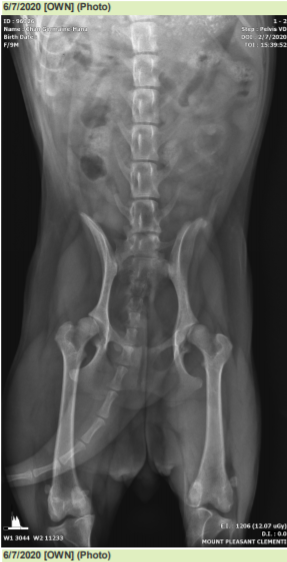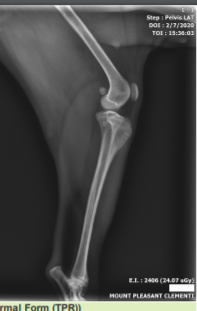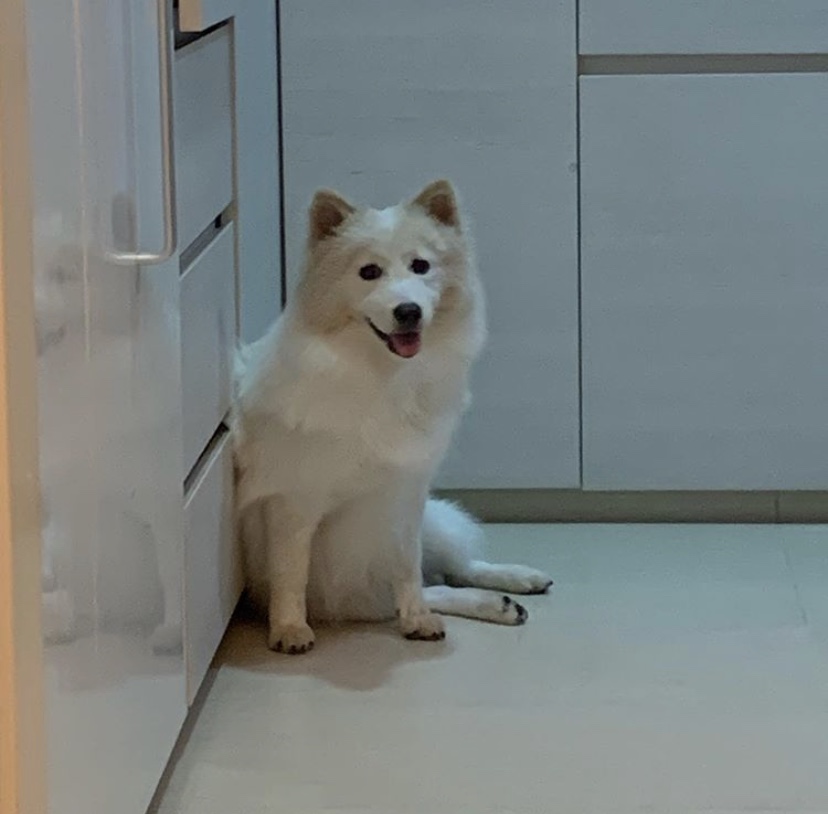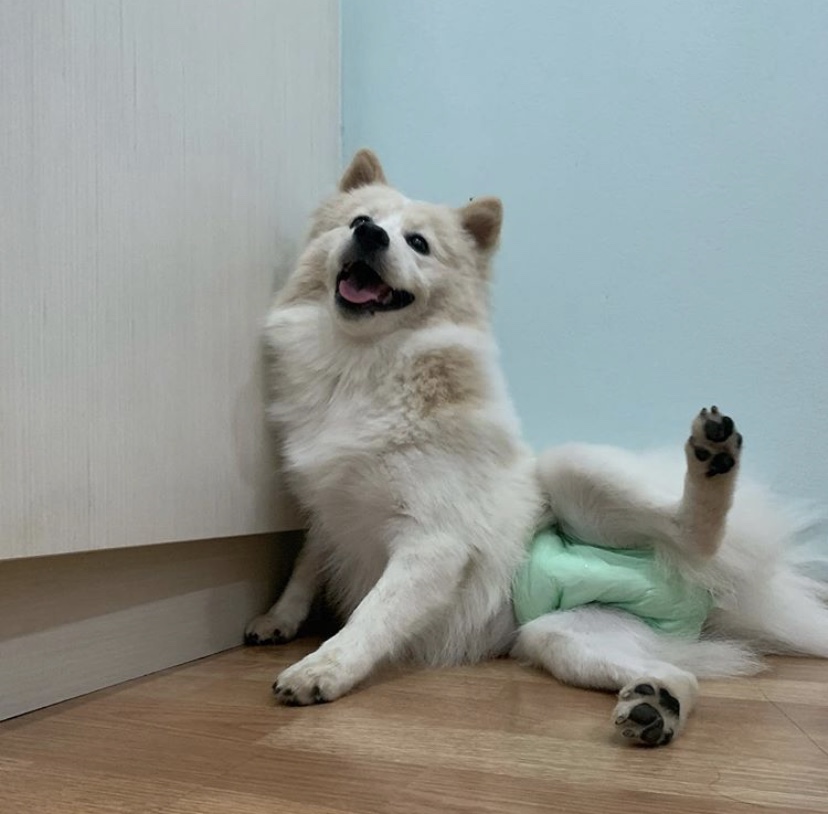In early July 2020, our family was met with some unexpected news. Our dog Hana was not only diagnosed with patellar luxation in her hind legs, but also hip dysplasia, at the tender age of 9 months. It was a double whammy for us. Between January to June, we had already made multiple trips to the vet to treat a variety of ongoing issues. But what made the situation even worse was the fact that Hana had already been displaying early symptoms of both conditions—right under our noses.
She had been quietly enduring the pain in her hips and joints, while we unknowingly brushed it off as a simple sprain that will naturally disappear and heal in no time. During the car ride home from the vet that day, many thoughts and unanswered questions went racing through my head. How did things come to this? Are we at fault for causing her to suffer so greatly? Will invasive surgery be a better or worse option?

The next few days went by in a blur. Each time I woke up in the morning, the only thought nagging inside my mind was Hana’s diagnosis. I read up many articles regarding HD and PL, sought for advice from people on Instagram, and also joined a specialized chat group hoping to gain more knowledge from other experienced owners. Fast-forward to present day, I’ve decided to compile my first-hand experience+what I’ve learnt, into this blog post, in the hopes of sharing what preventive measures you can start taking, as well as how to care for your dog—the natural way, if he or she has any hip or joint issues.
Now that I’ve shared with you some background information, I’ll be splitting the rest of this article into 2 main sections: Pre-diagnosis and Post-diagnosis.
- The Pre-diagnosis aims to share what are some red flags to keep an eye out for to prevent yourself from getting a dog who is likely to suffer hip or joint conditions AND if you suspect that your dog is suffering from these conditions. This section is especially important for potential first-time owners who are planning to welcome a new puppy into their household/already own a puppy.
- The Post-diagnosis aims to share our experience at RehabVet, some lifestyle changes we have made for Hana to address her needs, as well as several natural remedies that can prevent/ maintain hip and joint conditions in dogs.
Pre-diagnosis
Where you get your puppy from matters. I cannot stress this further enough. Did you know that majority of the adorable puppies sold in local pet shops are sourced from unethical puppy mills and unregistered breeders—whose sole purpose is to produce puppies for profit? Temperament, health and breed standards are rarely taken into consideration. One of the main woes of owners today is the fact that many puppies are very sickly and can suffer from several health issues, even before the age of 1.
- If you are reading this post as a potential new owner, I highly recommend and suggest getting your puppy from a trusted and registered breeder overseas. These breeders show love and care to their dogs as they sincerely want to ensure that the dogs are being bred to be best in temperament, health and standard. Sure, the price you pay+amount of paperwork done for an imported breed will definitely be much higher than a local one, but then again, Affordable and Cheap ≠ Healthy dog. More than oftentimes, you’ll end up paying the price of unethical breeding through mountains of medical bills—just like we did.
- This article: tinyurl.com/ImportJS written by @i.am.fuji_haku (IG) gives a very detailed and in-depth insight on importing a puppy into Singapore. A must read for anyone who plans to get a puppy, be it imported or local.
Red flag #1: We purchased Hana from a disreputable pet shop. Lets call it TC. When we asked them to show us images of her parents, the staff declined our request. They were also unable to produce health certificates to justify that her parents were hip-scored and tested to be free from hip dysplasia. This goes to show the poor level of transparency most pet shops have here.
Red flag #2: Hana’s health certificate as provided by TC after a vet check-up, did not display her knee grade for both knees e.g. Grade 1,2,3 etc. Strangely, it was left blank but we proceeded with making the purchase thinking that was just a harmless mistake.
Red Flag #3: When we met Hana for the first time, the staff did not allow her to walk on the floor. We were only allowed to carry her on our laps. Why not walk on the floor? They said that the puppies will then be easily susceptible to bacteria and germs. Looking back now, I believe that they did so in order to prevent unsuspecting owners from noticing any hobbling/limping in any puppies’ legs.
Never turn a blind eye on possible symptoms. We learnt it the hard way when Hana started limping and “bunny-hopping” in her left hind leg at the start of May. When that ceased to subside over a few days, we decided to call up the vet and book an appointment. However, since this was during the circuit breaker period and priority for vet visits was given to severe cases, the vet told us to send in videos first, and assess whether the limping was severe enough to require a physical diagnosis. Based on the videos sent, the vet told us not to worry as it was just a minor sprain that will eventually heal on its own. Our initial worries faded away…but even that was just temporary.
Red flag #4: Hana started limping occasionally in her left hind leg during her daily walks and at home. She also developed the habit of shifting both hind legs to the left side when sitting down.
Red flag #5: At the end of June, we brought Hana for her first full grooming session at a groomers’ place near our home. The entire duration of the session? 5 hours. The groomer told us that Hana constantly kicked her legs up, and refused to stand for long periods of time. Instead, she chose to lie down on the groomer’s table and so the grooming process took way longer than it should. We suspect that she had low pain tolerance in her joints and thus was unable to stand up for long periods of time during the grooming session.
Red flag #6: Since young, Hana has a bad habit of tugging at the leash in an attempt to walk/run ahead of us during walks. This often results in her pulling against the leash and leaning sideways when we make her walk beside us, thus straining her hind legs immensely.
After seeking advice, we were told that harnesses encourage dogs to pull more frequently, and so we switched to using both collars and harnesses. If you are concerned over collar tension, you can use a martingale collar instead. They are known to be effective training collars that can reduce pulling and tugging, whilst remaining loosely fitted unless pulled.

Post-diagnosis
Over the next few days, I sought for help and advice from fellow owners via Instagram. These owners also had dogs diagnosed with either hip dysplasia or patellar luxation. I had a relatively long and informative conversation with one of them. Coincidentally, her dog also came from the same pet shop as Hana did, and was suffering from severe hip dysplasia. Eventually, she sent her dog for a surgical procedure as its hips were already dislocated. Another owner whose dog suffered from grade 3 patellar luxation in both hind legs also sought for surgery. On the contrary, we currently send Hana for weekly rehabilitation at RehabVet to maintain both hip and joint conditions from further deterioration.
With many owners opting for surgical procedures, you may be wondering—why didn’t we choose surgery as well? At first glance, surgery seems like a viable solution. For patellar luxation, surgical correction is often recommended for dogs with grades 2, 3 and 4. It aims to keep the patellar in place at all times. In severe cases of canine hip dysplasia, surgery is also recommended as the best possible treatment. Surgery costs for both joint and hip procedures differs according to the type of surgical procedure you think is best for your dog.

Shortly after speaking to our Mt Pleasant vet regarding surgery options, we sought for a second opinion at RehabVet (https://rehabvet.com/), which specialises in rehabilitation, physiotherapy and hydrotherapy. Our consultation session lasted one full hour and cost us SGD$180. During the session, a series of tests were conducted to deduce the severity of Hana’s hip and joint conditions. The rehabilitation therapist Janny Chen concluded that Hana had overworked her tricep muscles, shifted majority of her weight onto 3 limbs and had more muscular front legs as compared to other growing puppies. It was also evident that Hana was in a lot of pain, as she screamed and whined loudly throughout the session.
Towards the end, our therapist laid out 2 different options: we could either send Hana in for surgery to treat both hips and joints (that makes 2 surgical procedures), or seek rehabilitation treatment to naturally manage and maintain the pain. The reasons why we decided on rehabilitation treatment are listed below:
- My family and I felt uncomfortable over the thought of Hana undergoing an invasive surgery, let alone two different procedures.
- Post-surgery complications may arise and can lead to even more detrimental effects on Hana.
- Even after a successful surgery, rehabilitation is still required for her to regain strength and balance in her affected hips and joints.
- The people at RehabVet were very understanding towards our concerns and told us that many of their patients (especially puppies) opted for rehabilitation instead, and are thriving well with a change in lifestyle.
- We were told that puppies diagnosed with hip/joint conditions are better able to “bounce back” to their regular selves by simply undergoing rehabilitation.
- We wanted Hana to live a more comfortable life, in the most natural, non-invasive way possible. Prior to this, she was constantly on medications and antibiotics to treat a multitude of issues that cropped up over the first few months of her life.
After confirming our decision for Hana to start rehabilitation, we then signed up for a package of 10 sessions (rehabilitation+physiotherapy), costing SGD$1300 (for small breed). Package prices differs depending on the breed’s size. If keen, you may wish to visit https://rehabvet.com/ for more information on their various services.
It is also important to note that every dog’s rehabilitation/physiotherapy journey differs on a case-by-case basis. While some dogs are able to start hydrotherapy (swimming) almost immediately, the team at RehabVet advised us to start slow and work on strengthening her weak joints before starting hydrotherapy. Thus, our first few sessions were mainly focused on building up muscle strength in her joints+alleviating pain in the hips and back.

Our rehab sessions took place once per week on Wednesday afternoons. From Week 1-5, Hana underwent laser therapy and stretching exercises (rehabilitation) to soothe her sore muscles and ease the pain felt in her joints, hips and back.

From Week 6-9, Hana underwent both laser therapy and physiotherapy in the form of hydrotherapy (swimming). The hydrotherapy sessions were conducted in a mildly heated pool, under the supervision of a hydrotherapist. Owners are welcome to step into the pool as well.

Since starting on her rehab journey 10 weeks ago, it is evident that improvements have been made in Hana’s hip and joints! The limping/bunny-hopping has slowly but gradually ceased in her left hind leg, and her back+tricep muscles are less sore than before.
As I’m writing this article, Hana has yet to attend her 10th and final session of the package, but will be visiting again next week. From what I know, the last session will still see her undergoing rehab and hydrotherapy. Additionally, the same series of tests conducted during the first consultation will be done again, to record and compare any significant areas of improvement being made after time spent on rehabilitation. After that, it is up to the owners to decide on whether to continue on a next package of 10 sessions or take a break from rehab etc. (For us, we will likely continue with another set of 10 sessions.)
After sharing my experience with RehabVet, I’ll now be moving on to several changes we’ve implemented into Hana’s daily lifestyle:
#1 Stretch, stretch, stretch!: Shortly after starting rehab, we were advised to carry out stretching exercises for Hana’s joints, twice a day on a daily basis. This was done so right after she woke up in the morning and before she goes to sleep at night. Heat packs also had to be placed on the joints area.
#2: No climbing of stairs: As per professionals’ advice, we have stopped letting Hana climb up or down staircases, and carry her instead. Other forms of movement deemed strenuous on the hind legs such as jumping has also been kept to a minimum.
#3 Transition to raw: Somewhat of a controversial topic amongst owners and experts alike, raw diets for pets are nonetheless gaining much traction and popularity within the pet community. The moment I stumbled upon this “new” feeding method last year, it made complete sense to me that raw feeding was the most natural, nutritional and wholesome feeding method for both dogs and cats. My family on the other hand, were initially skeptical over this diet. After much persuasion, Hana is now on a DIY raw+home-cooked food diet. Because I’m feeding her on a DIY raw diet, nutritional imbalances are more likely to occur. Thus, I recently sought for help and advice from an expert @twomanylegs (IG) to create a balanced meal recipe that will be especially beneficial for Hana’s hip and joints. She took both issues into consideration and so made a recipe that has higher levels of manganese, antioxidants and omega-3 fatty acids. If you are unable to consult an expert or prefer to craft your own recipe, you can head over to https://rawfedandnerdy.com/, or join raw feeding communities on social media platforms to gain advice and knowledge on raw feeding.
#4 We bought a pram: Nope, not the one for babies—but the one made just for pets. We bought our pram (used condition but relatively new) off Carousell for a reasonable price of SGD$50, and often bring it out during “excursions” to outdoor locations such as cafes, parks and neighbourhoods. Before getting a dog, whenever my family and I saw a dog in a stroller, we’d ogle at it and wonder why its owners didn’t allow it to walk on the floor instead. How the tables have turned! Nowadays we often see children and adults pointing at Hana in her pram, openly asking why there was a dog in the pram. Sometimes, I even felt like just pasting a piece of cardboard in front of the pram explaining the reason (lols!) All in all, the pram was a great transportation mode for Hana. Gone are the days when we had to carry her halfway through walks till our arms went slightly sore. You can try your luck by finding a pet pram on Carousell like we did, or get one off Shopee which also sells affordable prams.
#5 Supplements: Before the diagnosis, Hana was taking Augustine Approved powder on a daily basis. Now, we’ve also added in Canine Rose-hip Vital powder as well as Connectin Hip & Joint powder in a bid to improve her overall conditions. Rose-hip powder is one of the most popular and well known kinds of supplements that owners feed their dogs for better joint health. You can read more about the benefits of rosehip powder via https://rosehipvitalcanine.com.sg/. Besides powdered supplements, we also provide her with tablets—mainly M&C Kalsium and Antinol. If your pet is fussy with powdered/tablet supplements, or you prefer liquid ones, feel free to visit https://perromart.com.sgcollections/nhv for a variety of liquid-based supplements that supports joint health. For other powdered supplements, I’ve also heard great reviews about Happy Again joint supplement. You can find it here: https://shop.vanillapup.com/products/happy-again-collagen-joint-supplement.
#6 Yummy bone broth: Bone broth is a delicious, prized stock liquid made using any type of bones and simmered over a period of 24 hours. It is also common to throw in additional vegetables/herbs/fungi for a boost of flavour and nourishment. The many benefits of bone broth includes protecting the joints and improving gut health. Strangely, Hana seems to dislike bone broth (she is a very picky eater). I made several batches using chicken feet, pork bones, celery, carrots, turmeric and ACV, on different occassions using a pressure cooker, but Hana never finished her meals when I added the broth in. Over here https://thepetlifestyleguru.com/benefits-of-bone-broth/ includes some useful recipes for you to get started on making bone broth for your pet. If you value convenience, there are also ready-made options available on the market. One local brand I highly recommend is The Awoo’s Kitchen (@the_awookitchen on IG), as their rich, jelly-like golden broths are popular choices among the owners and pets alike! If their slots aren’t fully booked for the month yet, you can make a purchase on their website https://theawookitchen.com/.
#7 Correcting the “Ah Pek” sitting style: As mentioned earlier, one red flag that Hana displayed pre-diagnosis was shifting all her body weight onto one side of her hind legs. This is not a recommended sitting position as it can add further strain onto the “good” hind leg that the dog is leaning on. She still does it sometimes, but less frequently than before. When we see her sitting “Ah Pek” style, we’ll encourage her to get up on all fours and sit down normally instead. We’ll also coax her to stand back up before carrying her to the bed, which provides a softer cushioning on her joints.
And…That’s all folks!
You’ve finally come to the end of my long article (laughs). I’ve had lots of fun writing this as it gave me the chance to reflect back on Hana’s rehabilitation journey from start till now, albeit the fact that we still have a long way to go. So far, we’ve met so many helpful and experienced owners who’ve stepped forward to share their own personal experiences on having a dog with hip/joint conditions, or simply to share useful nuggets of advice with me. Some things that I’ve written here would not have been possible without the help of these people! So thank you very much:)
The reason why I decided to compile my experience here on Pawjourr is because many other owners have approached me on social media seeking for words of advice, or simply to share Hana’s journey so far. Thus, I jumped upon the chance to pour out all that I had wanted to say to other fellow owners on social media, but couldn’t due to limited word count+limited time to process my thoughts properly.
I hope that you found this article useful! You can follow us @hanathecloud on Instagram to see more regular updates of Hana, or to ask any further questions:D
Until next time, sayonara!

“Bye bye!” *waves* 
Wink wonk
* This blog is designed to be a community where pet owners can learn and share. The views expressed in each post are the opinion of the author and not necessarily endorsed by Pawjourr. Always consult your veterinarian for professional advice.




